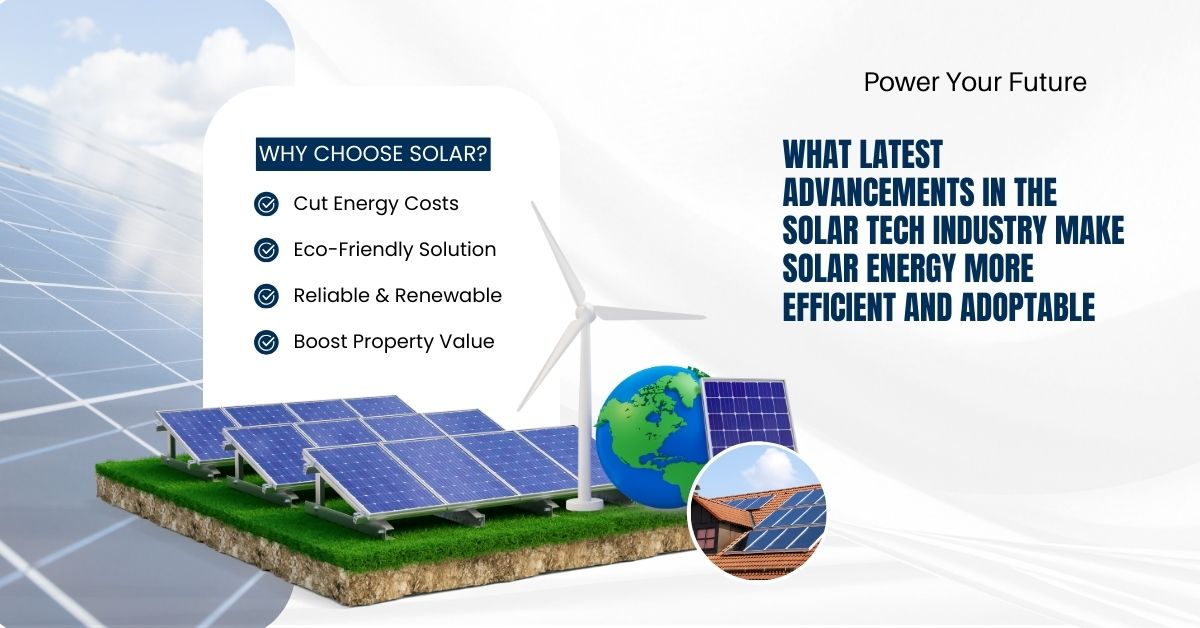What Latest Advancements in the Solar Tech Industry Make Solar Energy More Efficient and Adoptable
Know the details about What Latest Advancements in the Solar Tech Industry Make Solar Energy More Efficient and Adoptable, Discover the latest advancements revolutionizing the solar tech industry! Explore cutting-edge innovations like high-efficiency solar panels, energy storage breakthroughs, and smart integration systems that make solar energy more efficient and accessible than ever before. Learn how improved photovoltaic technologies, durable materials, and AI-driven energy management are driving widespread adoption for homes and businesses.
Stay informed on how these developments reduce costs, increase reliability, and maximize energy output. Whether you’re an eco-conscious homeowner or a tech enthusiast, uncover how the solar industry is reshaping the future of sustainable energy. Embrace the power of tomorrow, today!
Table of Contents
What Latest Advancements in the Solar Tech Industry Make Solar Energy More Efficient and Adoptable
Solar energy has come a long way since its inception as a viable energy source. As the world moves toward sustainable solutions for energy generation, the solar technology industry has witnessed remarkable advancements that enhance the efficiency, affordability, and adaptability of solar systems. This blog explores the latest innovations in solar energy technology, focusing on breakthroughs that make solar power more efficient and accessible for consumers, businesses, and governments.
High-Efficiency Photovoltaic Cells

A. Perovskite Solar Cells
One of the most exciting developments in the solar industry is the advent of perovskite solar cells. These cells offer a unique crystal structure that enhances light absorption and energy conversion. Unlike traditional silicon cells, perovskites are lightweight, flexible, and cheaper to produce.
Key Benefits:
- Efficiency rates exceed 30%, compared to the average 20-25% of silicon cells.
- Potential for tandem solar cells by layering perovskites over silicon to maximize energy capture.
- Reduced manufacturing costs due to low-temperature processing methods.
B. Bifacial Solar Panels
Bifacial panels can capture sunlight on both sides, significantly improving energy yield. They are particularly useful in reflective environments like deserts or snowy regions.
- Yield increases by 10-20% compared to conventional panels.
- Durable and long-lasting designs suitable for harsh weather conditions.
C. Quantum Dot Technology
Quantum dot solar cells use nanoscale semiconductor particles to capture sunlight. These advanced materials improve light absorption across various wavelengths, making them suitable for indoor and low-light applications.
Advancements in Solar Storage Solutions
A. Next-Generation Batteries
Energy storage is critical for managing solar power’s intermittent nature. Cutting-edge batteries like solid-state and lithium-sulfur are redefining storage capabilities.
- Solid-State Batteries: Safer, longer lifespan, and higher energy density compared to lithium-ion batteries.
- Lithium-Sulfur Batteries: Lightweight and cost-effective, with higher capacity for large-scale applications.
B. Hydrogen Storage
Solar energy can now be used to produce green hydrogen through electrolysis, offering an innovative way to store energy over long periods. This hydrogen can then be converted back into electricity or used as a clean fuel.
Innovative Solar Panel Designs
A. Building-Integrated Photovoltaics (BIPV)
BIPV technology integrates solar panels directly into building materials like roofs, walls, and windows.
- Eliminates the need for separate panels, making solar installations seamless and aesthetically pleasing.
- Popular designs include solar shingles and transparent solar windows.
B. Flexible and Lightweight Panels
Flexible solar panels made from thin-film materials are revolutionizing solar energy applications.
- Ideal for irregular surfaces like vehicles, boats, and portable devices.
- Lightweight construction reduces transportation and installation costs.
C. Solar Skins and Customization
Solar skin technology allows panels to blend with roofs by mimicking textures and colors.
- Enhances the visual appeal of residential and commercial buildings.
- Does not compromise on energy efficiency.
AI and IoT Integration
Artificial Intelligence (AI) and the Internet of Things (IoT) are transforming solar energy management.

- Predictive Analytics: AI algorithms forecast weather patterns and optimize solar energy harvesting.
- Smart Inverters: IoT-enabled inverters improve grid interaction by managing energy flow more efficiently.
- Remote Monitoring: Users can track their system’s performance in real-time, ensuring quick detection and resolution of issues.
Concentrated Solar Power (CSP) Improvements
CSP systems use mirrors or lenses to concentrate sunlight onto a small area, generating heat to produce electricity. Recent advancements have enhanced CSP efficiency:
- Molten Salt Storage: Enables energy storage for up to 10 hours, ensuring reliable power even after sunset.
- Holographic Optics: Improves sunlight concentration while reducing material costs.
- Supercritical CO2 Turbines: Enhance thermal energy conversion efficiency, making CSP systems more competitive.
Recycling and Sustainability Initiatives
The solar industry is addressing environmental concerns related to panel disposal by investing in recycling technologies.
- Recyclable Solar Panels: Manufacturers are designing panels with recyclable materials to reduce e-waste.
- End-of-Life Management: Programs aim to recover valuable materials like silver and silicon from old panels.
- Circular Economy Practices: Encouraging the reuse of components to minimize environmental impact.
Decentralized Solar Systems
Decentralized solar systems are gaining popularity, especially in remote or underserved areas.
- Microgrids: Allow communities to generate and manage their solar power independently of the main grid.
- Portable Solar Kits: Provide affordable solutions for off-grid households in developing countries.
- Peer-to-Peer Energy Trading: Blockchain-enabled platforms allow users to trade excess solar energy locally.
Solar-Powered Transportation
Solar energy is making significant strides in transportation, leading to eco-friendly mobility options.
- Solar Electric Vehicles (SEVs): Cars with integrated solar panels can extend driving ranges and reduce charging frequency.
- Solar-Powered Charging Stations: Promote the use of electric vehicles by offering renewable energy sources for charging.
- Solar Boats and Planes: Innovative designs for marine and aviation industries demonstrate solar power’s versatility.
Global Policy and Investment Trends
Supportive policies and increasing investments are driving solar energy adoption worldwide.

- Subsidies and Tax Credits: Many governments offer incentives to make solar installations more affordable.
- Corporate Investments: Companies like Tesla and First Solar are investing in R&D to advance solar technology.
- International Collaborations: Initiatives like the International Solar Alliance promote global cooperation in solar energy development.
Challenges and Future Outlook
Despite the advancements, challenges remain in scaling up solar adoption:
A. Material Constraints
Rare materials like indium and tellurium, used in some solar cells, face supply limitations.
B. Grid Integration
High solar penetration requires upgrading infrastructure to handle variable energy inputs.
C. Public Awareness
Educating consumers about the benefits of solar technology remains crucial for widespread adoption.
Future Opportunities:
- Space-Based Solar Power: Collecting solar energy in space and transmitting it to Earth via microwaves or lasers.
- Next-Gen Materials: Innovations like graphene and organic photovoltaics promise to push efficiency limits.
FAQs About What Latest Advancements in the Solar Tech Industry Make Solar Energy More Efficient and Adoptable
Conclusion
The solar technology industry is undergoing a transformative phase with advancements that enhance efficiency, reduce costs, and expand applications. From high-performance photovoltaic cells to AI-driven energy management, these innovations are paving the way for a sustainable energy future. As technology continues to evolve, solar energy is poised to become a cornerstone of the global transition to renewable power.
With the combined efforts of governments, corporations, and individuals, the dream of a cleaner and greener planet is closer than ever before. The latest advancements in solar technology ensure that this dream is not only achievable but also highly practical.

